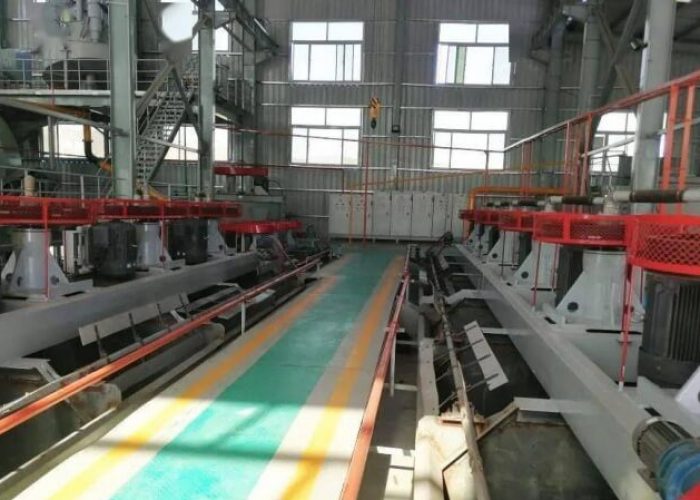At present, with the development of economic construction, the demand for copper and molybdenum is increasing. The characteristics of copper-molybdenum ore polymetallic mineral resources include more lean ore and less rich ore, serious co-association, many other useful components, and finely embedded particle size, which makes the separation of copper-molybdenum ore difficult. Therefore, the copper-molybdenum ore separating process is particularly important.

Copper-molybdenum ore is one of the main sources of molybdenum. Chile, the United States, Canada, Peru, Mexico and the Soviet Union are the main countries that recover molybdenum concentrate from copper-molybdenum ore.
The natural floatability of molybdenum ore is good, so the molybdenum ore beneficiation process of direct flotation after crushing and grinding is often used. The useful minerals in copper-molybdenum ore are chalcopyrite, chalcocite, molybdenite, etc. In the production practice process, copper-molybdenum ore is often separated by flotation.
Copper molybdenum flotation separation process
At present, the use of flotation to treat copper-molybdenum ore is more common, the technology is mature, and the indicators are good. In principle, the flotation methods of copper-molybdenum ore are mixed flotation, preferential flotation, and equal flotation. Most of the production chooses mixed flotation, but sometimes preferential flotation or equal flotation is also used.
1. Mixed flotation Process
Most copper-molybdenum ores adopt the mixed flotation-copper-molybdenum separation process, because molybdenite and chalcopyrite have similar floatability and serious concomitant, and this process has lower cost and simpler process.
In general, the mixed collectors of flotation machine use xanthate (butyl xanthate), auxiliary collector hydrocarbon oil (kerosene), terpineol oil as foaming agent, lime and water glass as regulators. Ye Lijia conducted an experimental study on a low-grade copper-molybdenum ore in Anhui and found that when kerosene was used as a collector and BK301C was used as an auxiliary collector for copper-molybdenum mixing, the recovery rate of copper and molybdenum could reach 93.3 g/t at a dosage of 59 g/t, respectively. 01% and 73.2%, the effect is much better than other auxiliary collectors.
(1). Pre-processing stage:
Usually, the separation process of copper and molybdenum has two schemes: suppressing molybdenum and floating copper and suppressing copper and floating molybdenum. Since molybdenite is more easily floating, most of them adopt the method of suppressing copper and floating molybdenum. However, when separating high-copper and low-molybdenum ores, the process of suppressing molybdenum and floating copper should be considered, because copper suppression will result in high pharmaceutical costs. In addition, molybdenite has good floatability, and inorganic or organic small-molecule inhibitors are not easy to play, which makes some high-molecular inhibitors such as dextrin, starch, humic acid, tannic acid, etc. to be used.
(2). Inhibition stage:
After pretreatment, copper and molybdenum separation can be carried out. An important aspect is the separation of flotation inhibitors. Commonly used inhibitors can be divided into two categories: inorganic substances and organic substances. Inorganic substances are mainly Knox, cyanide, sodium sulfide, etc., and organic substances are mainly thioglycolate, which can be used alone or mixed.
(3). Concentrate stage:
After the separation of copper and molybdenum, the next step of molybdenum separation and copper separation should be carried out. Generally, molybdenum needs six separations to meet the requirements of smelting. Sometimes part of the molybdenum in the mixed floating concentrate is not completely dissociated, and the regrinding process is inevitable. Copper separation is relatively simple, generally only one separation, but the technology of asynchronous mixed flotation is worth mentioning, that is, flotation of easy-to-float copper first, and then enhanced flotation of difficult-to-float copper (adding mixed xanthate). , mixed two-step copper concentrate, re-grinding and re-separation.

2.Priority flotation Process
For low-grade molybdenum-copper ore, while ensuring the grade and recovery rate of molybdenum concentrate, the comprehensive recovery of copper should also be considered. Sometimes it is more appropriate to use preferential flotation. In the copper-molybdenum ore, if the copper secondary generation is serious and the oxidation rate is high, the chalcopyrite inlaid particle size is fine, and the phenomenon of being wrapped by gangue is serious. Molybdenite is embedded in gangue fissures and between grains. The process is to float molybdenum first, then grind to separate copper and molybdenum, and flotation molybdenum tailings to recover copper.
3. Equal flotation Process
Generally speaking, both preferential flotation and mixed flotation require high alkalinity (lime) to achieve separation of copper, molybdenum and sulfur. Lime has an inhibitory effect on molybdenum, which is not conducive to the recovery of molybdenum.
Equal flotation can avoid such problems, and use selective collectors to separate copper, molybdenum and sulfur without using or using less lime.
It has little interference to the next step of copper-molybdenum separation and molybdenum separation, which is beneficial to obtain better indicators.
Mixed flotation separation is used in the separation of most copper-molybdenum ores, and sometimes preferential flotation and other flotation are also worthy of consideration. The key is that the grade of copper and molybdenum in the raw ore, the characteristics of the embedded particle size and other characteristics will affect the dosage of chemicals, grinding and other links. That is, the level of economic cost of beneficiation and the quality of beneficiation indicators. The separation of effective pretreatment and mining equipment is the key stage of copper-molybdenum mixed flotation and re-separation.